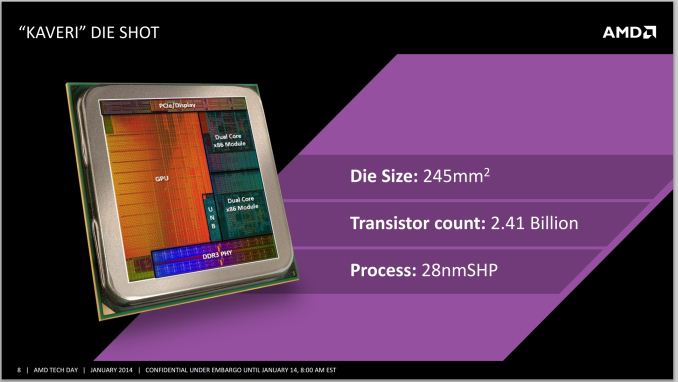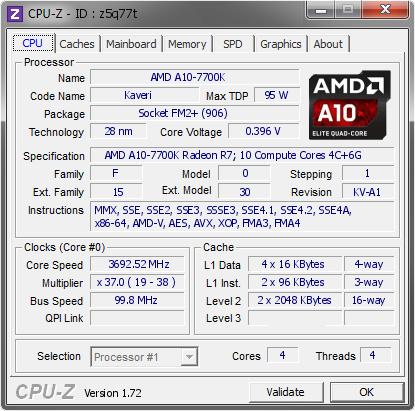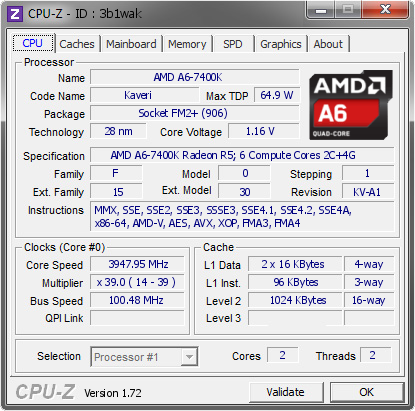The AMD A10-7700K and AMD A6-7400K CPU Mini-Review
by Ian Cutress on May 27, 2015 9:00 AM ESTAMD A10-7700K and AMD A6-7400K Conclusion
I started this mini-review stating that the question of the number of processors that both Intel and AMD produce all seem to differ by 100 MHz and $7, and that I had received questions as to why this is the case. Ultimately a lot of recommendations for computer components start to revolve around ‘Well for $10 more, you could get this’, and at some point you are considering something that costs $50 more. There has to be a point where you stop, especially if an IT department or system builder wants to go through and develop 200+ machines in a month.
Intel and AMD currently have different approaches to this. Intel likes to launch a big part of its stack all at once. Sometimes it will launch individual units outside this, or it will start a new line-up with one or two units then introduce the bulk later. With Haswell for example, on the socketed CPU space, we have 50 different CPUs varying in price, power, frequency, core count, threading and integrated graphics. Imagine the poor reviewer that has to test them all (insert here that I’d love to test them to get all the data, if I had time and could source them)!
AMD’s approach to Kaveri is to dribble rather than gush. Rather than overload the user base (both end-users and commercial) with a large haystack of parts, they launched two or three SKUs on day one, then one or two every 6-12 weeks since. This has some benefits, namely the improvement of the production process over time, the repeated opportunities to market new products and the opportunity to re-educate potential clients through the media. The downside of this strategy is one similar to starting with Swiss cheese and then filling in the holes – if a client wants a SKU with particular characteristics but the company does not have it, then they will go look for something else and take their money with them. It’s a method that acts as a double edged sword.
As AnandTech’s CPU editor, I get to play with a lot more SKUs than most. This means both the big shiny halo products, such as the 8-core goliaths, but also some of the higher volume dual core stuff which is more in line with a budget PC or mass PC build. With AMD’s strategy, as they have fewer processors overall, our coverage can be a little more complete than the others. AMD sampled us both the A10-7700K and the A6-7400K for this purpose, and we hope to work closely with them for future launches and get the best comparison list of their product stack.
Back to the SKUs tested for this mini-review, we can tell that the A10-7700K keeps up with the other A10 parts in our CPU testing, but as it has two fewer compute units in the integrated graphics it can lag behind a little and is more in line with the A8 processors in that regard, essentially making it more of a hybrid part. The A6-7400K fits into that budget CPU line at $64, and the results show this in both our CPU and GPU testing. The single module performs well enough in single threaded environments, but doesn’t have enough legs for the big tasks and can be swamped easily. Despite having two threads, the Bulldozer based design still has single-threaded like behavior in some tests. That being said, the graphics tests are a mixed bag. For titles that can use more threads, I can’t help but feel that it is a little held back, even at 256 SPs. For other titles, it performs on par with other processors almost double its price. Dual Graphics mode unfortunately was not possible with the A6, and it was also noticeable that some games (Shadows of Mordor in particular) took longer to load with only one module.
To say AMD’s APUs are like marmite (you either love them or hate them) is to gloss over a more complex issue. AMD’s design has its plus points and its negative points, a fact that AMD marketing knows when I speak to them. Nevertheless, they have to focus on the plus points, which include gaming at equivalent price points, DX12 support, OpenCL performance and moving forward with HSA. Using the right tool for the right job should now be considered a cliché, but it rings true when it comes to technology and more so than ever when innovative methods are continually being fashioned. Based on AMD’s Financial Analyst Day and their recent exposure into HBM (I highly suggest reading Ryan’s awesome writeup on it), I can safely say that I want to see an APU with HBM in the future. Despite the inevitability that AMD already know that people want one, I told them anyway. We will have to wait and see.














105 Comments
View All Comments
leexgx - Thursday, May 28, 2015 - link
they need to update CPU-z to correctly show that the Modular CPU on the new cpus of AMDor at least show core as modules as they are effectively a single core CPU or dual core performance wise, AMD currently does not have a Quad core CPU in the current line up (Quad Module)
akamateau - Thursday, May 28, 2015 - link
I can't disagree with your assessmant of AMD marketing. It is non-existant. But what is worse is when wirters such as Ian Cutress LIE to their readers.These new AMD releases ALL are meant for Windows 10 and DX12. Where are the DX12 benchmarks?
Cutress has 3dMark API Overhead and Starswarm yet he benches new products with an OBSOLETE API: DX11.
Why doesnlt he bench them using DX12?
As a wrieter Cutress is obkiged to write about ALL of the facts not just those that he wants the consumer to know or those facts that Intel pays him to cover-up.
So Cutress what;s it going to be? Are you GUTLESS or do you have the STONES to show us the DX12 benchmarks?
jospoortvliet - Thursday, May 28, 2015 - link
These APU's are only useful for playing old games - DirectX 11, thus. Those fancy, non-existent DirectX 12 games will most likely be too heavy for it anyway. Heck, he should test DirectX 9 games, rather than DX 11...UtilityMax - Friday, May 29, 2015 - link
And guess what, as you can see from the benchmarks, the iGPU from the A10 line does not make almost any difference over the iGPU from the A8 line. On paper, A10 has 1/3 mode GPU processing units, but in reality both are starved for memory bandwidth, so it makes almost no difference if you use A10 or A8 GPU. Looking at all the benchmarks, the A8-7600 is the most solid choice among the Kaveri parts. It loses almost nothing to the A10 line in terms of performance, while costing less and burning less power.ES_Revenge - Saturday, May 30, 2015 - link
Keep in mind there *are* i5s that are dual-core--essentially i3s with turbo. Clarkdale i5s (i5-6xx) are all that way, and ALL laptop/mobile i5s are dual-core + HT + turbo. I'm not saying the 7700K should have the A10 name (it shouldn't, I agree) but it's not like Intel doesn't have exceptions to their branding as well.Shadowmaster625 - Wednesday, May 27, 2015 - link
That A8-7650K is a really nice part. The 7700k seems rather redundant.xenol - Wednesday, May 27, 2015 - link
I can't wait for a Zen based APU with HBM. I'm yawning at seeing Bulldozer derivatives.r3loaded - Wednesday, May 27, 2015 - link
Yep, especially when a $72 Intel CPU matches or beats all of AMD's offerings in everything except iGPU gaming and heavily multithreaded workloads.Edens_Remorse - Wednesday, May 27, 2015 - link
You are mistaken if you think the G3258 beats the 860k in gaming when discrete graphics are involved.nandnandnand - Wednesday, May 27, 2015 - link
Anything pre-Zen from AMD is a waste of space at this point.